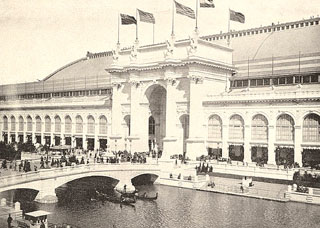Fairs and Phantoms
By Hope Wallace
When my niece was up from North Carolina a few weeks ago, she slapped a book in my lap. The book’s cover looked interesting, with a brooding old photograph of an obviously architecturally significant building nestled behind a long, wide lagoon. Oooohhh. It was dark, and kind of creepy and beautiful all at the same time.

Through some of my classes in college I learned a little bit about the 1893 World’s Columbian Exposition that occurred in Chicago, but being busy I most likely dismissed it as I moved on to the next assignment. Really, how might a fair be much different than the state and world fairs we have today? Devil in the White City by Erik Larson is a non-fiction account of the construction and operation of the 1893 World’s Columbian Exposition in Chicago, along with a record of the first recorded serial killer in the United States: H.H. Holmes. Even with the dark events going along simultaneously with this monumental exhibition, I realized how important fairs, no matter their size, are to a city, county, state, country and the world.
This massive project, once drawings were approved and it had passed numerous city and national committees, required 200 buildings on 600 acres to be built in under two years. In addition, events, exhibits, rides, food, logistics and molding the hostile Lake Michigan coastline to suit, all had to happen during a significantly depressed worldwide economy and rise from the ashes of the Chicago fire.
And? Cool stuff comes out of the imagination, ingenuity and, most importantly, the commitment of a community to create. Celebrating the 400th anniversary of Christopher Columbus’ landing, this exposition introduced many inventions and practices we use to this day. It was four times larger than the previous World’s Fair held in Paris in 1889, where Gustave Eiffel unveiled his latticework tower. Some other notables are as follows:
• Light bulbs were put more widely into use
• Westinghouse AC current was adopted
• Fluorescent lights were introduced
• Electric boats
• Pabst Blue Ribbon beer
• Juicy Fruit gum
• Quaker Oats
• Shredded wheat
• The first spray paint
• George Washington Ferris introduced his engineering marvel, the Ferris Wheel, at 250 feet high (the current Ferris Wheel at Navy Pier in Chicago is 150 feet high).
• Braille printing
• Picture postcards and commemorative stamps
• First nighttime football game
The Columbian Exposition was instrumental in launching the then filthy, rough and impoverished city of Chicago towards the cultural mecca it is today. Chicago’s citizens rallied and gathered for hours outside newspaper publishers simply awaiting the news regarding whether the fair would come to their city. They did not burn coal while the fair was open from May-October so as not to darken the white buildings. A total of 27 million people visited in a country that contained 63 million at the time. Since the buildings were created to be temporary, and people could not bear to watch them degrade, they were mysteriously set on fire in 1894. You can still see their beauty, however, in Jackson Park, where the Manufactures & Liberal Arts building became what we know now as the Museum of Science & Industry, and the lagoons and island are still present.
Be sure to check out our Van Wert County Fair booth. We’ll be there to answer any questions you may have about our classes and programs. Our artists have finished the paintings that will be hung in the old treasurer’s office windows. Jack Merriweather of Paulding, Weston Thompson of Van Wert, Brooke Lancey of Youngstown, Kay Sluterbeck of Van Wert, Matt Temple and I had a fun time depicting fair scenes to brighten the exterior. A big thanks to Matt for directing the painting project! We had some great fine art entries in the County Fair Fine Art Exhibit this year and judging, as usual, was difficult. Everyone did a great job and we encourage you to sign on next year to exhibit and perhaps to volunteer to host the display.
Our current exhibit ends September 5. The history of the peony goes back to Greek mythology and Jens Svendsen has depicted this tale in a mural. His wife, painting professor at BGSU, Mille Guldbeck also is displaying paintings, which pay homage to the American Garden. Mille has worldwide representation. As always, admission to this exhibit is free. The show is sponsored by First Federal Savings & Loan of Van Wert.
The Hot Air Festival Plein Air Paint Out is coming up soon and will be held Friday and Saturday, September 7-8. Plein Air translates roughly to “open air” and there are painters who specialize in this technique. Attracted to the way light interprets our world, plein air painters often work quickly to capture what we see outside. A painting sale will follow the paint-out and cash prizes will be awarded. This is open to anyone over 18 who likes to paint, and registration information can be found on our website and Facebook page. The competition is sponsored by Dr. and Mrs. Kevin Laing. Applications are also available here at the art center and at the fine arts display at the fair.
The Wassenberg Art Center’s hours during exhibits are: Tuesday through Sunday 1–5 p.m. and you may contact the art center at 419.238.6837, by email: info@wassenbergartcenter.org or via our website at: wassenbergartcenter.org. The Wassenberg Art Center is located at 643 South Washington Street in Van Wert.
POSTED: 08/29/12 at 1:14 pm. FILED UNDER: What's Up at Wassenberg?







